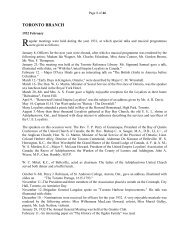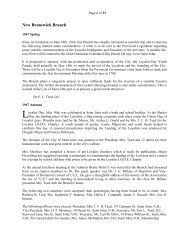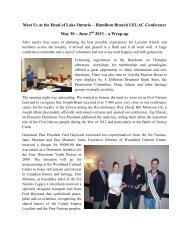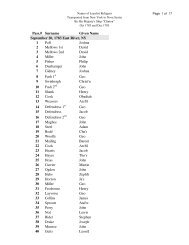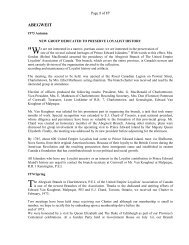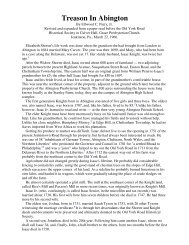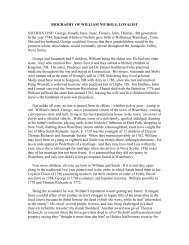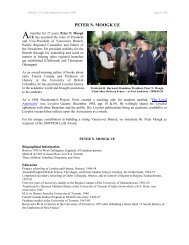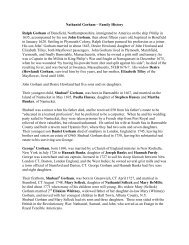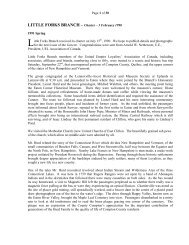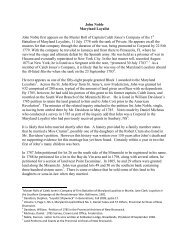Joshua Knight Information - for United Empire Loyalists
Joshua Knight Information - for United Empire Loyalists
Joshua Knight Information - for United Empire Loyalists
Create successful ePaper yourself
Turn your PDF publications into a flip-book with our unique Google optimized e-Paper software.
<strong>Joshua</strong> <strong>Knight</strong> <strong>In<strong>for</strong>mation</strong><br />
<strong>Knight</strong>, <strong>Joshua</strong> of Abington. Memorial, now of Beaver Harbour, NB, 1786. He abandoned his<br />
property immediately after the Battle of Germantown in 1777 and remained in British lines throughout<br />
the rest of the war. Claim <strong>for</strong> 141 acres twelve miles from Philadelphia, a house, blacksmith’s shop and<br />
tools. Letter from Isaac <strong>Knight</strong> dated NYC 16 November 1783 to the claimant:<br />
Dear children, I have got your estate appraised according to an Act of your Parliament by<br />
Abraham Tyson and John Shoemaker and thy brother John’s likewise . . . I have taken on me to<br />
grant a power of attorney in thy stead and name . . . hoping that thee will not blame me <strong>for</strong> it<br />
because I have no other view in it to induce me to act as I have but the most tender affections of an<br />
ancient parent. Your mother is very bad with the rheumatism. Thy children when I left home were<br />
well and all the rest of us are in the usual state of health, <strong>for</strong> which blessing I am very thankful.<br />
Hoping these times find you all in the same state of health. I am in<strong>for</strong>med you are in miserable<br />
country. Thee has not complied with thy promise in writing to me but I am doubtful your situation is<br />
so bad that you are afraid to give me a genuine account. I rest with the most tenderest affection to<br />
you both and children. P.S. The reason of my appointment of two of thy trusty friends is, as they are<br />
agoing in two ships and each of them will have one power of the same sort, I hardly expect both will<br />
miscarry if one should.<br />
Letter from John <strong>Knight</strong> dated Digby, 16 April 1784, to <strong>Joshua</strong> <strong>Knight</strong> at Passamaquaddy:<br />
Dear brother, I take this opportunity by our friend Hincksman of letting thee and my dear sister<br />
and family know that I am in tolerable good state of health, blessed be the Great Disposer of all<br />
Events <strong>for</strong> his many favours. Though I have had a very hard winter by Distress both of body<br />
and mind, I came to Annapolis last fall with a view of settling there but had such a tedious<br />
passage that the evacuation just taking place when I returned to New York, the vessels being<br />
thick crowded and my wife not in a circumstance to go to sea, was once more obliged to leave<br />
her but luckily our good old father came to New York and she went home with him to stay the<br />
winter: I am just going to fetch her . . . I could get no vessel coming to Annapolis and was<br />
obliged to go to Port Roseway, from that I took passage to Halifax which was near being my<br />
last as we were several times near being cast away . . . the vessel being so loaded with ice she<br />
would not steer the first harbour we made called Sheet Harbour .. . Four of us thought the best<br />
to fly the wilderness where there was no sign of any inhabitants . . . rather than stay on board<br />
and starve, though I expected nothing but to perish in the wreck. Two soldiers and two women<br />
that had gone to begin a settlement . . . got us Indian pilots, otherwise we should have perished.<br />
We was 45 days from Roseway to Halifax . . . I saw Jesse Lawrence in Halifax and gave him<br />
the estimate to thy estate.<br />
From “Early New Brunswick Probate Records 1785-1835” by R. Wallace Hale:<br />
<strong>Knight</strong>, <strong>Joshua</strong><br />
Parish of Pennfield, Charlotte Co., Blacksmith.<br />
Will dated 25 3mo 1797, proved 23 September 1801.<br />
Wife Sarah entire estate <strong>for</strong> life. Son <strong>Joshua</strong> Lot 2 that he now lives on, 200 acres, blacksmith tools,<br />
assorted books (including the Laws of Pennsylvania and History of New England), 3 guns of his<br />
choice. At wife’s death residue of estate to my four children Isaac <strong>Knight</strong>, Priscilla PAUL, Jonathan<br />
<strong>Knight</strong> and <strong>Joshua</strong> <strong>Knight</strong>. Granddaughter Margrate <strong>Knight</strong> 5 pounds at age 18. Wife Sarah and son<br />
<strong>Joshua</strong> executors. Witnesses: Elias Wright, (a Quaker), Evan Thomas, (a Quaker), and AnnWright
(wife of Elias Wright). Sarah <strong>Knight</strong> renounced executorship. Son <strong>Joshua</strong> <strong>Knight</strong> noted as `being of<br />
the profession of the People called Quakers` in probate records.<br />
Inventory, dated 28 of 10mo 1801, valued at 228 pounds by Evan Thomas, Elias Wright and Isaac<br />
Justason.<br />
(Transcribed from the original which appeared in the Courier.) The Courier is pleased to publish<br />
a series of articles on local history in order to keep readers in<strong>for</strong>med of the diverse and important<br />
undertakings of the Charlotte County Historical Society. Any persons wishing to donate funds,<br />
artifacts or support the society and the museum [<strong>for</strong>mer Murchie House in Milltown Heights] in any<br />
way, are asked to contact Bob Shreve in St. Stephen, George Smith in Pomeroy Ridge, Rose<br />
Haughn in St. Andrews or any other society member.<br />
History of Beaver Harbour and Some of the First Families<br />
Compiled by Mrs. A.W. Hawkins<br />
Presented March, 1967<br />
To get a clear understanding of the history of Beaver Harbour, also called Penn’s Field Colony,<br />
Pennfield Colony and Bellevu (or Belleview), one should go back to earlier days and find why and how<br />
people came to settle there.<br />
During the Monmouth Rebellion in England, there was a group called the Society of Friends of<br />
Quakers, who refused to take up arms against Catholic King James II and <strong>for</strong> this they were branded as<br />
rebels and many were thrown into prison and suffered great persecution. This led to many of them<br />
leaving England and coming to the colony of Pennsylvania.<br />
Years later, <strong>for</strong> almost the same reason `Loyalist` descendents of these same people were leaving<br />
Pennsylvania and migrating to Canada because they would not swear allegiance to the <strong>United</strong> States of<br />
America against England. In 1783 one group under the leadership of <strong>Joshua</strong> <strong>Knight</strong> made arrangements<br />
to go to the colony of Nova Scotia of which New Brunswick was then a part.<br />
Early in 1773 <strong>Joshua</strong> <strong>Knight</strong> had sought British protection in New York and he and many of his<br />
followers went there. <strong>Joshua</strong> was a man of prominence from Arlington, Penn. He was descended from<br />
Elizabeth Shorter, wife of John Rush, Sr., captain of the horse under Cromwell.<br />
In June 1783 a group of people met at <strong>Joshua</strong>`s New York home and a month later the following<br />
advertisement appeared:<br />
NOTICE<br />
Notice is hereby given to those of the people called Quakers who have entered into an agreement to<br />
settle together in Nova Scotia that they are requested to meet at the house of <strong>Joshua</strong> <strong>Knight</strong> No. 30<br />
Chatham Street a little above the Sea Water Pump on the seventh day next of the 5th of July at four<br />
o’clock in the afternoon in order to conclude upon some matters of importance to them and those who<br />
mean to join the above mentioned body.<br />
They are requested to call No. 188 Water Street between the Coffee House Bridge and the Fly<br />
Market and have their names entered as soon as possible. No slave master admitted.<br />
It is interesting to note that the Quakers were antagonists of slavery 80 years be<strong>for</strong>e Lincoln’s<br />
emancipation proclamation.<br />
Forty-nine names were signed to this agreement.<br />
The Settlement<br />
The place chosen <strong>for</strong> settlement through John Parr of Halifax and Governor Carleton was Beaver<br />
Harbour or Bellevu. The settlers were brought to Saint John, N.B., by ship under convoy. One ship was<br />
the Camel, 293 tons, Capt. William Tinker, and arrived 18 September, 1783. A list of the people she<br />
carried includes James Reed, Pilot, wife and two children; 30 children over the age of 10 years found as
supernumeraries <strong>for</strong> victuals and victualles at two-thirds of all provisions (spirits except) by order of<br />
Rear Admiral Digby; also <strong>Loyalists</strong> and refugees, consisting of 104 men, 50 women, 20 servants as<br />
well as 47 children who received half rations.<br />
Nearly all the passengers of the Camel belonged to two special companies of Quakers and<br />
Anabaptists. They were immediately sent down the shore by ship to Beaver Harbour where they settled<br />
what was to have been a large town by the name of Bellevu. They suffered many hardships during the<br />
first winter.<br />
One hundred and <strong>for</strong>ty-nine lots were laid out as first grants, and these were soon followed, by 950<br />
more. There were 15 streets and 800 residents when the town was incorporated June 4th, 1785. Three<br />
agents were appointed, Samuel Fairlamb, John Rankin and George Brown.<br />
Original Grantees of Beaver Harbour town plots: John Rankin, Isaac Woodward, Peter Walton,<br />
Samuel Fairlamb, Samuel Stilwell, Daniel Registar, John <strong>Knight</strong>, Nimrod Woodward, Thomas Buckley<br />
Sr., <strong>Joshua</strong> <strong>Knight</strong> Sr., Caleb Paul, Caleb Paul, Jesse Lawrence, Elias Wright Sr., Moses Foulk,<br />
Benjamin Brown, <strong>Joshua</strong> <strong>Knight</strong>, John Gill, John Horner, John Horner, John Dennis, John<br />
Loufbourron, William Holmes, John Harris, Joseph Harris, Joseph Parker, John Horner, Elias Wright,<br />
<strong>Joshua</strong> <strong>Knight</strong>.. John Horner, Elias Wright Sr., Elias Wright, Abraham Woodward, Jeremiah Fills,<br />
Richard Mead, Anthony Woodward, Jacob Buffington, Freeman Smith, John Strickland, Joseph<br />
Tomlinson, George Bennison, Jesse Woodward ,Richard Matthews, Amos Strickland, Samuel<br />
Woodward.<br />
0nly two families are now living their original grants, J.L. Wright (a direct descendent of Elias<br />
Wright, Loyalist) and Alvah Eldridge(a direct descendent of William Eldridge, Loyalist).<br />
Early Records<br />
Among the records of the Pennfield Colony we find the following which is taken from pages of<br />
record books found in an old trunk at Pennfield but since believed destroyed.<br />
“Agreed by the said Company that they do meet on the seventh day of the week and the 16th of the<br />
seventh month to build a meetinghouse.”<br />
This house was to be used by Quakers. In 1875 record shows that land was cleared <strong>for</strong> a burying<br />
ground. This land is now the property of the Baptist Church, Beaver Harbour. There are no stones to<br />
mark it as a burying ground because the Quakers did not believe in markers. Members of the <strong>Knight</strong><br />
and Cross families are buried there. The last known burial was of Asa Best, son of John and Ann Best,<br />
about 75 years ago. This grave was marked until recent years.<br />
The last entry in the old Records, written by an unknown hand, reads<br />
“At a meeting of Friends at the Meeting-House, Beaver Harbour, <strong>for</strong> settling the business of the<br />
Society on the 10th day 3 m 1789, Jacob Buffington, John Dennis, Daniel Registar and Richard Mead<br />
were appointed a committee to examine the accounts and proceedings of the committee who distributed<br />
the provisions which were received from friends from England <strong>for</strong> this place and to report thereon”<br />
Little by little, it became evident they could not make a living here and in 1789 the Affairs of the<br />
Association were closed up.<br />
The Great Fire<br />
In 1790 Bellevu was destroyed by a <strong>for</strong>est fire. Elias Wright’s was the only house saved. The<br />
meeting house and all records were lost. Elias Wright, Loyalist from New York, Magistrate and grantee<br />
of Saint John, married (first name not known) Kline. Elias Wright was also a grantee of Bellevu, and<br />
died in 1825, age 76, at Beaver Harbour. His son, Elias Wright, 1784 - 1854, married Mary Walton,<br />
daughter of Jesse Walton. Both are buried in Pennfield Baptist Churchyard.<br />
In 1794 we have the record of a Quaker wedding at Pennfield. <strong>Joshua</strong> <strong>Knight</strong> Jr., married Jane<br />
Vernon, daughter of Moses Vernon.
Scattering of Settlement<br />
After the fire many of the settlers moved to Pennfield Ridge, Pocologan, New River and Mace’s<br />
Bay. In fact, Mace’s Bay was first settled by five loyalist families from Beaver Harbour. <strong>Joshua</strong><br />
<strong>Knight</strong>’s dream of a large colony with Bellevu as its city was now crushed. Only a few struggling<br />
settlers remained to rebuild the little village of Beaver Harbour.<br />
The following appears in the Winslow papers, 1803.<br />
“Parish of Pennfield, population 54”.<br />
Rebuilding<br />
Gradually more families began moving into Beaver Harbour. They were excellent farmers and lived<br />
quite com<strong>for</strong>tably. There was plenty of land <strong>for</strong> all as the first settlers had abandoned their grants. The<br />
new-comers settled on small farms and fished and farmed <strong>for</strong> a living. They were Anabaptists and<br />
Anglican and a few Quakers. There were two saw mills which cut about 400,000 feet of lumber<br />
annually. Two Vessels were built at Beaver Harbour - about 250 tons.<br />
(There appears to be a missing section here, but I do not have it.)<br />
him of 10 lbs. of sugar, seven pieces of broadcloth, six pieces of cotton and all his wife and<br />
children’s clothing. They also took Capt. Cross’ boat and fishing lines, etc. After loading Capt. Cross’<br />
boat and their own with plunder they said they were sorry that they had no more boats to load.<br />
The sturdy men of Charlotte County were not the kind to be overawed and stand idly by while their<br />
friends and neighbours were being robbed. A number of them collected and manning three boats went<br />
after the buccaneers, put them to rout and drove them ashore.<br />
There is a traditional story that on another occasion, the marauders sailed into the Harbour under<br />
cover of darkness and stole nearly all of George Wright’s flock of geese. One of the group made a bag<br />
with a piece of sail-cloth put a penny in the bag <strong>for</strong> each goose stolen and tied it around the gander’s<br />
neck with the following note:<br />
“Mr. Wright: We bid you goodnight. We stole your geese at a penny apiece and left the pay with the<br />
Gander.<br />
This petty plundering was carried on under the plea of legitimate warfare <strong>for</strong> although these small<br />
boats could not in any manner be described as sea-going vessels yet they all acted under a commission<br />
of the President of the <strong>United</strong> States of America which entitled them to treatment as prisoners of war if<br />
captured.<br />
On another occasion an American naval ship, or man-o-war as they were then called, fired at the<br />
rock in the middle of Beaver Harbour. This rock was called Rams Head by the settlers as it resembled<br />
the head of a ram, the cannon balls knocked out great pieces of the rock so we now have one ram’s<br />
head minus his horns.<br />
On some early maps, Ram’s Head is called Jail Rock. It has also been known as Sailors Rock. This<br />
harks back to times when naval ships landed sailors there whom they wished to punish. They were left<br />
with little to eat and tied to a ball and chain <strong>for</strong> such time as their superior officers saw fit to leave<br />
them, depending on the nature of their crime which in those days need be very minor.<br />
There is a traditional story that a man by the name of Antonio escaped and swam ashore. His true<br />
last name was not known but is spelled Wadlin today. He was hidden by the people in the village, lived<br />
and married there. Thus began the present Wadlin families of Beaver Harbour.<br />
--------------<br />
Saint Croix Courier, St. Stephen, NB June 22, 1893<br />
GLIMPSES OF THE PAST - Contributions to the History of Charlotte County and the Border<br />
Towns.<br />
LXXII – PENN’S FIELD.<br />
There appears to be no existing record of the date of the arrival of the Pennfield colonists.
Their leader, <strong>Joshua</strong> <strong>Knight</strong>, came from Abbington, a suburb of Philadelphia. With other members<br />
of the society of Friends, he had sought protection in New York; and his abandoned property was<br />
confiscated by the Whig authorities.<br />
Early in 1783, the following advertisement was published in New York:-<br />
Notice is hereby given to those Belonging to the Society of people commonly called Quakers, and to<br />
those who have had a Birthright among them, and now wish to promote that Society, and have made A<br />
Return of their names in Order to be removed to the river St. Johns in Nova Scotia, that it is the request<br />
of some of that Society that they will call at No. 188 in Water street between the Coffee house Bridge<br />
and the fly market(1), where a mode of proceeding will be Proposed to them, which it is expected will<br />
be agreeable to them: in so doing they will oblige Several Well wishers to that Society.<br />
In answer to the above, <strong>for</strong>ty-nine persons agreed to settle on ‘the river St. Johns in Nova Scotia,’<br />
and adopted the following regulations:-<br />
Rules and regulations <strong>for</strong> the Government of the society of people called Quakers, who settle<br />
together on the river St. Johns Nova Scotia, to be entered in their book of records as a standing rule to<br />
them, and Kept inviolate by every Member of Said society-<br />
Article 1st. that a proper Book be procured by said society in which their proceedings shall be<br />
recorded, and that a Clark be appointed annually to make a fair entry of the Same<br />
2nd. that every publick matter which concerns the society in general, shall be Determined by a<br />
Majority of votes of the members of the society who are arrived to the age of Twenty one years.<br />
3rd. that five persons belonging to said Society shall be appointed annually by the members of the<br />
Society, to hear and determine all complaints and controversies which May arise in Said society, and<br />
that any three of the A<strong>for</strong>esd persons meeting Shall be a sufficient number to hear and determine in<br />
those cases<br />
4th. that no slaves be either Bought or sold nor kept by any person belonging to Said society on any<br />
pretence whatsoever(2)<br />
5th. that in case any dispute or complaint shall be Brought be<strong>for</strong>e the committee appointed <strong>for</strong><br />
Settling complaints and Disputes by a person not Belonging to said society, it Shall be their duty to See<br />
Justice done to the Complainants as soon as possible<br />
6th. that no person belonging to the Said Society Shall be permited or have a right to Sell or Convey<br />
the lands aloted to him in said society to any person which the said Society Shall not approve of -<br />
those regulations to remain in <strong>for</strong>ce until some others may take place.<br />
The original memorandum of agreement is of such interest that we reproduce it in facsimile:-<br />
[<strong>Joshua</strong> <strong>Knight</strong>, John Rankin, John Loofbourrow, Samuel Fairlamb, Gidn. Vernon, Amos<br />
Strickland, Evan Griffith, Joseph Tomlinson, John Strickland, Peter Price, Nathaniel Loufbourrow,<br />
Daniel Regester, Samuel Tomlinson, Peter Woltma(n), Abram Rankin, Samuel Stillwell, Joseph<br />
Thorne, Jeremiah Frith, Moses Winder, Thomas Buckley Junior, Thomas Buckley, John Burk, Edward<br />
Burk, Andrew Hamton, Benj. Brown, Richard Buffington, Jonathan Paul, John Dennis, Mathias Kizer,<br />
Richard Lawrence, Nimrod Woodward, Isaac Woodward, Jno. Hineham, Rachel Done, widow, Joseph<br />
Way, Daniel Southwick, Jon(athan) Remington, Gershom Remington, Richard Mathews, Abraham<br />
Wood Ward, Amos White, Jesse Walton, Anthony Woodward, Anthony Woodward, Junr., Abner<br />
Hamton, Wm. Reynolds, Robert Woodward, Jacob Woodward, George Fielder.]<br />
This document was written fifty years be<strong>for</strong>e the abolition of slavery in the British West Indies, and<br />
eighty years be<strong>for</strong>e the emancipation proclamation in the <strong>United</strong> States. The fact that slavery then<br />
existed in New England, and that some of the New York <strong>Loyalists</strong> who settled in other parts of Nova<br />
Scotia brought slaves with them, makes its anti-slavery declaration the more remarkable. (2)<br />
At a meeting of the society on the 5th day of June, 1783, it was agreed that three agents should be<br />
appointed to locate their lands; and Samuel Fairlamb, John Rankin and George Brown were selected<br />
<strong>for</strong> the purpose.<br />
A month later the following advertisement appeared:-
Notice is hereby given to those of the people called Quakers who have entered into an agreement to<br />
settle together in Nova-Scotia that they are requested to meet at the house of <strong>Joshua</strong> <strong>Knight</strong>, No. 36 in<br />
Chatham-street, a little above the Tea-Water Pump, on Seventh Day next, the 5th of July, at four<br />
o’clock Afternoon, in order to conclude upon some matters of importance to them; and those who mean<br />
to join the above-mentioned body are requested to call at No. 188, Water-street, between the Coffee-<br />
House Bridge and the Fly-Market(1), and have their names entered as soon as possible.<br />
New York July 2, 1783.<br />
They had reached their destination, as we have seen, be<strong>for</strong>e Oct. 12. The story of their journey, and<br />
of their arrival at Beaver Harbor, is unknown to the writer, and further in<strong>for</strong>mation on the subject<br />
would be gladly received.<br />
A vessel bringing the Quakers and their goods probably accompanied one of the later fleets sailing<br />
<strong>for</strong> St. John. It may be surmised that the agents had chosen Beaver Harbor as a place of settlement in<br />
preference to any lands they found available on the St. John river, and made their report to that effect<br />
when the ship arrived. If this were so, the same ship would probably have brought them to Beaver<br />
Harbor. Their new settlement was called ‘Penn’s Field,’ in honor of the founder of Pennsylvania.<br />
The subsequent history of the settlement shows that lots were drawn by persons who never came,<br />
and that some who did come remained but a short time, and went away leaving their lots unimproved.<br />
Redistribution was made from time to time; and a list of grantees of certain lots in 1787 contains the<br />
following additional names:-<br />
Samuel Stillwell, John <strong>Knight</strong>, Caleb Paul, Elias Wright, Moses Foulk, Benjamin Field Brown, John<br />
Gill, John Horner, James Harris, Joseph Parker, Jeremiah Fitz, Richard Mead, Jacob Buffington,<br />
Freeman Smith, <strong>Joshua</strong> <strong>Knight</strong>, jr., George Bennison, Jesse Woodward, jr., Evan Thomas, Robert<br />
Robbins, Samuel Woodward.(4)<br />
Tradition says that the Pennfield settlers brought a considerable amount of property with them; but<br />
this appears doubtful, as we know that the colony received aid from friends in England.<br />
(1) The word, ‘Fly,’ in this name, is a corruption of the Dutch word ‘Vallei.’ The following note<br />
from Mrs. Lamb, editor of the Magazine of American History and author of the History of the City of<br />
New York, explains its use:-<br />
The Fly Market was near the foot of what is now called Maiden Lane. It was a salt meadow with a<br />
creek running through it into the East River, when the market was established there. The Dutch word<br />
<strong>for</strong> valley was ‘v’lei’ – thus it was commonly styled the ‘V’lei-Market,’ and hence the corruption into<br />
‘Fly-Market.’ Being on the East River it was a convenient place <strong>for</strong> meetings.-Martha J. Lamb.<br />
(2) ‘No slave master admitted,’ to my mind, makes that page one of the most magnificent in all our<br />
history, or in any history.-W. F. Ganong.<br />
(3) It seems to me not improbable that the Quakers left New York in a fleet of 26 sail under convoy<br />
of the Magician frigate of 40 guns and the Tarrier sloop of war, which sailed from Sandy Hook <strong>for</strong><br />
different parts of Nova Scotia, on Saturday, July 12, 1783. In this case, they might have come to St.<br />
John, and, finding the delays in alloting grants, have removed, say in the month of August, to Beaver<br />
Harbor. It will be remembered that there was an inclination in the minds of St. John <strong>Loyalists</strong> to<br />
remove in considerable numbers to Passamaquoddy.-W. O. Raymond.<br />
(4) Early in the present century Elias Wright was living in Pennfield, at Beaver Harbor, as I have<br />
heard my father speak of stopping at his house there when on his way to Saint John. Jacob Buffington<br />
seems to have been a land surveyor, as I have often heard of Buffington’s lines, in the eastern part of<br />
Charlotte County.-E. Jack.<br />
http://members.shaw.ca/caren.secord/locations/NewBrunswick/Glimpses/LXXII.html<br />
(article submitted by Kathleen Smith)




